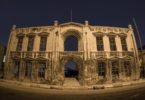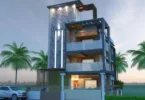Architecture is a form of art. And when it comes to art there is no fixed rule. The same goes for architecture. Architects follow no fixed grid lines when it comes to architectural styles. As a result, many styles are followed around the world. We’ve listed the most popular styles that will inspire you to make unique designs.
1. Minimalism:
Minimalism is an architectural style that emphasizes simplicity and a pared-down design aesthetic. The style emerged in the 1960s and 1970s as a response to the excesses of modernist architecture, which was seen as overly decorative and wasteful. Minimalist architecture favors clean lines, neutral colors, and a focus on the essentials, creating a calming and uncluttered environment.
Key characteristics of minimalist architecture include:
- Simple forms: Minimalist buildings often feature simple geometric shapes like squares or rectangles.
- Neutral colors: Minimalist buildings typically use neutral colors, such as white, black, or shades of gray.
- Use of natural light: Minimalist architecture emphasizes natural light, with large windows and skylights that bring the outdoors in.
- Emphasis on function: Minimalist buildings are designed with a focus on function rather than decoration, emphasizing creating efficient and practical spaces.
- Limited materials: Minimalist buildings often use a limited range of materials, such as concrete, steel, and glass, to create a sense of unity and simplicity.
- Minimalist landscaping: Minimalist buildings often feature minimalist landscaping, with simple geometric shapes and a focus on native plants.
Examples of minimalist architecture include the work of architects such as Mies van der Rohe, Richard Meier, and Tadao Ando. Famous minimalist buildings include the Farnsworth House by Mies van der Rohe, the Getty Center by Richard Meier, and the Church of the Light by Tadao Ando.
2. Brutalism:
Brutalism is an architectural style that emerged in the 1950s and 1960s. The name “Brutalism” comes from the French word for raw concrete, “béton brut.” The style is characterized by its use of raw concrete and a stark, imposing appearance. Brutalist buildings often feature heavy, geometric forms and emphasize functionality over aesthetics.
Key characteristics of Brutalist architecture include:
- Raw concrete: Brutalist buildings often use raw concrete as their primary building material, left unadorned and exposed to create a sense of massiveness and solidity.
- Heavy, geometric forms: Brutalist buildings often feature heavy, geometric forms, such as cubes, rectangles, and cylinders.
- Minimalism: Brutalist architecture often emphasizes simplicity and minimalism, focusing on functional design rather than decoration.
- Bold, striking shapes: Brutalist buildings often feature bold, striking shapes that stand out in their surroundings, creating a sense of drama and impact.
- Brutalism in landscaping: Brutalist architecture often includes minimalist landscaping, with simple geometric shapes and a focus on native plants.
- Use of natural materials: Some Brutalist buildings incorporate natural materials such as wood or stone to soften the harshness of the concrete.
Examples of Brutalist architecture include the National Theatre in London, the Boston City Hall, and the Habitat 67 housing complex in Montreal. While Brutalism has been criticized for its starkness and lack of warmth, it has also been praised for its honesty and integrity in design.
3. Bauhaus
Bauhaus architecture style is characterized by its minimalism, functionality, and use of industrial materials. The movement aimed to combine art and technology in a way that would benefit society as a whole. Bauhaus architecture emphasized using modern materials, such as steel, glass, and concrete, to create simple, efficient, and visually striking buildings.
Some key features of Bauhaus architecture include:
- Cubic forms: Bauhaus architects favored simple, geometric shapes like cubes and rectangles.
- Flat roofs: Bauhaus buildings typically had flat roofs emphasizing their simple, functional design.
- Large windows: Bauhaus architects used large windows to bring natural light into buildings and create a sense of openness.
- White walls: Bauhaus buildings often had white walls emphasizing their clean, minimalist design.
- Open floor plans: Bauhaus architects often designed buildings with open floor plans, which allowed for flexible use of space.
Bauhaus architecture style has had a profound influence on modern architecture and design. Its emphasis on simplicity, functionality, and industrial materials has been echoed in countless buildings and products over the past century.
4. Gothic Architecture:
Gothic architecture is a style of architecture that emerged in Europe during the Middle Ages, roughly between the 12th and 16th centuries. It is characterized by its use of pointed arches, ribbed vaults, and elaborate ornamentation. Gothic architecture is often associated with the great cathedrals and churches of Europe, such as Notre-Dame Cathedral in Paris and Westminster Abbey in London.
Key characteristics of Gothic architecture include:
- Pointed arches: Gothic architecture is characterized by its use of pointed arches, which allowed for greater height and a sense of upward movement.
- Ribbed vaults: Gothic architects developed ribbed vaults, which allowed for greater structural stability and a more intricate, decorative ceiling.
- Flying buttresses: Gothic architects used flying buttresses to support the weight of the high, vaulted ceilings, allowing for larger windows and more open interior space.
- Elaborate ornamentation: Gothic architecture features elaborate decoration, including carved stone reliefs, stained glass windows, and intricate sculptures.
- Verticality: Gothic architecture emphasizes verticality, with tall, narrow structures that draw the eye upward and create a sense of awe and majesty.
- Decorative elements: Gothic architecture often features decorative elements such as pinnacles, finials, and gargoyles, which add to drama and grandeur.
Examples of Gothic architecture is the Notre Dame Dame Cathedral in Paris, Westminster Abbey in London, and the Cologne Cathedral in Germany. Gothic architecture was praised for its grandeur, beauty, and religious symbolism but was also criticized for its excessive ornamentation and perceived lack of restraint.
5. Art Deco:
Art Deco architecture is a style that emerged in the 1920s and 1930s. It is characterized by its use of geometric forms, bold colors, and rich materials such as marble, bronze, and glass. Art Deco architecture is often associated with the glamour and sophistication of the Jazz Age.
Key characteristics of Art Deco architecture include:
- Geometric forms: Art Deco architecture features bold, geometric forms such as zigzags, chevrons, and sunbursts.
- Rich materials: Art Deco architects used luxurious materials such as marble, bronze, and glass to create a sense of elegance and luxury.
- Streamlined design: Art Deco architecture often features streamlined, aerodynamic designs influenced by the emerging technologies of the time, such as airplanes and automobiles.
- Bold colors: Art Deco buildings often use bold, contrasting colors to create a sense of drama and excitement.
- Decorative elements: Art Deco architecture features decorative elements such as stylized floral motifs, stepped forms, and sunburst patterns.
- Asymmetry: Art Deco architecture often features asymmetrical designs, with elements placed off-center to create a sense of movement and dynamism.
Examples of Art Deco architecture include the Empire State Building in New York City, the Hoover Dam in Nevada, and the Ocean Drive buildings in Miami Beach. While Art Deco was praised for its glamour and sophistication, it was also criticized for its excessive ornamentation and perceived focus on style over substance.
Organic Architecture:
Organic architecture is a style of architecture that emerged in the early 20th century and was developed by architect Frank Lloyd Wright. It is characterized by an emphasis on harmony with the natural environment, and a focus on integrating the building with its surroundings. Organic architecture is often associated with the Arts and Crafts movement and is seen as a reaction against the Industrial Revolution and the mass-produced, machine-made aesthetic of modernism.
Key characteristics of Organic architecture include:
- Integration with the natural environment: Organic architecture seeks to create buildings that harmonize with their natural surroundings, using materials and colors that blend in with the landscape.
- Use of natural materials: Organic architects use materials such as wood, stone, and brick that are found in nature and have a natural warmth and texture.
- Focus on a human scale: Organic architecture seeks to create comfortable and welcoming buildings for human occupants rather than imposing and intimidating.
- Emphasis on craftsmanship: Organic architecture celebrates traditional craftspeople’s skill and artistry, often featuring handcrafted details and ornamentation.
- Exploration of other forms: Organic architects often experiment with unusual shapes and forms, creating buildings that appear to grow out of the ground or mimic the curves and lines of nature.
- Sustainability: Organic architecture seeks to create environmentally sustainable buildings, using passive solar design and other techniques to reduce energy use and minimize environmental impact.
Examples of Organic architecture include Fallingwater in Pennsylvania, the Taliesin West campus in Arizona, and the Johnson Wax Headquarters in Wisconsin. While Organic architecture was praised for its integration with nature and emphasis on a human scale, it was criticized for its sometimes eccentric forms and perceived lack of practicality.
Conclusion
These are the most popular architectural styles used all over the world. Try these styles in your next design, and they will surely be praised by the crowd.








[…] Housing multiple vertical circulation cores within a one-minute radius of each other in the spine ensures that every worker takes at most 7 minutes to reach their office from the point of entry into the site. […]